Gross Ecosystem Product (GEP) Accounting and Sustainable Management Pathways for Wild Duck Lake National Wetland Park, Beijing, China
Abstract
1. Introduction
2. Materials and Methods
2.1. Overview of the Study Area
2.2. Research Methodology
2.2.1. Research Framework
2.2.2. Accounting Index System
2.2.3. Calculation Method and Data Description
2.2.4. Processing of Social Media Data
3. Results
3.1. Analysis of Land Use Status
3.2. GEP Accounting Results
3.3. Social Media Semantic Analysis Results
4. Discussion
4.1. Comparison of GEP Unit Values with Previous Studies
4.2. GEP Accounting Results Analysis
4.3. Social Media Analysis
4.4. Management Implications and Strategies
4.5. Limitations and Future Directions
5. Conclusions
Supplementary Materials
Author Contributions
Funding
Data Availability Statement
Acknowledgments
Conflicts of Interest
References
- Li, Y.; Xie, H. Spatial–temporal variation and correlation analysis of ecosystem service values and ecological risks in winter city Shenyang, China. Sci. Rep. 2024, 14, 18182. [Google Scholar] [CrossRef] [PubMed]
- Crutzen, P.J. Geology of mankind. Nature 2002, 415, 23. [Google Scholar] [CrossRef] [PubMed]
- Rockström, J.; Steffen, W.; Noone, K.; Persson, S.; Chapin, F.S.; Lambin, E.F.; Lenton, T.M.; Scheffer, M.; Folke, C.; Schellnhuber, H.J. A safe operating space for humanity. Nature 2009, 461, 472–475. [Google Scholar] [CrossRef]
- Polasky, S.; Kling, C.L.; Levin, S.A.; Carpenter, S.R.; Daily, G.C.; Ehrlich, P.R.; Heal, G.M.; Lubchenco, J. Role of economics in analyzing the environment and sustainable development. Proc. Natl. Acad. Sci. USA 2019, 116, 5233–5238. [Google Scholar] [CrossRef]
- Moomaw, W.R.; Chmura, G.L.; Davies, G.T.; Finlayson, C.M.; Middleton, B.A.; Natali, S.M.; Perry, J.E.; Roulet, N.; Sutton-Grier, A.E. Wetlands In a Changing Climate: Science, Policy and Management. Wetlands 2018, 38, 1–23. [Google Scholar] [CrossRef]
- Bartzen, B.A.; Dufour, K.W.; Clark, R.G.; Caswell, F.D. Trends in agricultural impact and recovery of wetlands in prairie Canada. Ecol. Appl. 2010, 20, 525–538. [Google Scholar] [CrossRef]
- Millennium Ecosystem Assessment. Ecosystems and Human Wellbeing: A Framework for Assessment. 2003. Available online: http://pdf.wri.org/ecosystems_human_wellbeing.pdf (accessed on 16 November 2025).
- Kumar, P. The Economics of Ecosystems and Biodiversity: Ecological and Economic Foundations; Routledge: London, UK, 2011. [Google Scholar]
- Wackernagel, M.; Onisto, L.; Bello, P.; Linares, A.C.; Falfán, I.S.L.; Garca, J.M.; Guerrero, A.I.S.; Guerrero, M.G.S. National natural capital accounting with the ecological footprint concept. Ecol. Econ. 1999, 29, 375–390. [Google Scholar] [CrossRef]
- Hein, L.; Bagstad, K.J.; Obst, C.; Edens, B.; Caparrós, A. Progress in natural capital accounting for ecosystems. Science 2020, 367, 514–515. [Google Scholar] [CrossRef]
- Costanza, R.; d’Arge, R.; De Groot, R.; Farber, S.; Grasso, M.; Hannon, B.; Limburg, K.; Naeem, S.; O’Neill, R.V.; Paruelo, J. The Value of the World’s Ecosystem Services and Natural Capital. Nature 1997, 387, 253–260. [Google Scholar] [CrossRef]
- United Nations; European Commission; Food and Agriculture Organization of the United Nations; Organisation for Economic Co-Operation and Development; International Monetary Fund, and World Bank Group. System of Environmental-Economic Accounting: Ecosystem Accounting (SEEA EA); United Nations: New York, NY, USA, 2021. [Google Scholar]
- IPBES. Global Assessment Report on Biodiversity and Ecosystem Services of the Intergovernmental Science-Policy Platform on Biodiversity and Ecosystem Services; IPBES Secretariat: Bonn, Germany, 2019. [Google Scholar]
- While, A.; Jonas, A.E.G.; Gibbs, D. From sustainable development to carbon control: Eco-state restructuring and the politics of urban and regional development. Trans. Inst. Br. Geogr. 2010, 35, 76–93. [Google Scholar] [CrossRef]
- The State Council of the People’s Republic of China. China’s National Plan on Implementation of the 2030 Agenda for Sustainable Development; The State Council of the People’s Republic of China: Beijing, China, 2021.
- European Commission. The European Green Deal; European Commission: Brussels, Belgium, 2019. [Google Scholar]
- SDGs Promotion Headquarters, Government of Japan. SDGs Implementation Guiding Principles (Revised Edition); Ministry of Foreign Affairs of Japan: Tokyo, Japan, 2019.
- National Research Council. Sustainability and the U.S. EPA; National Academies Press: Washington, DC, USA, 2011. [Google Scholar]
- United Nations General Assembly. Transforming Our World: The 2030 Agenda for Sustainable Development; United Nations: New York, NY, USA, 2015. [Google Scholar]
- Zhao, Z.; Xiong, K.; Ying, B.; Zhao, R.; Yan, J.; Huang, H. A Review of Eco-Product Value Realization and Eco-Industry with Enlightenment toward Village Ecosystem Service in the Karst Desertification Control. Sustainability 2024, 16, 4671. [Google Scholar] [CrossRef]
- Ruan, H. A Review of Value Realization and Rural Revitalization of Eco-Products: Insights for Agroforestry Ecosystem in Karst Desertification Control. Land 2024, 13, 1888. [Google Scholar] [CrossRef]
- Liu, J.; Su, X.; Liu, Y.; Shui, W. A Review of Research on Progress in the Theory and Practice of Eco-Product Value Realization. Land 2024, 13, 316. [Google Scholar] [CrossRef]
- Pacetti, T.; Lompi, M.; Panza, G.; Bosso, A.; Monaci, M.; Pasini, G.; Santolini, R. Gross Ecosystem Product as a Measure of Natural Capital Value: An Italian Experience. Earth Syst. Environ. 2025, 9, 2417–2435. [Google Scholar] [CrossRef]
- Rokicki, B.; M’barek, R.; Grammatikopoulou, I.; La Notte, A.; Van Alphen, M.; Van Zeist, W.; Bartelings, H.; Polman, N. Gross Ecosystem Product in Macroeconomic Modelling; Publications Office of the European Union: Luxembourg, 2024. [Google Scholar] [CrossRef]
- Costanza, R.; Kubiszewski, I.; Giovannini, E.; Lovins, H.; Mcglade, J.; Pickett, K.E.; Ragnarsdóttir, K.V.; Roberts, D.; De Vogli, R.; Wilkinson, R. Development: Time to leave GDP behind. Nature 2014, 505, 283–285. [Google Scholar] [CrossRef]
- Bronzes, A.; Hein, L.; Groeneveld, R.; Pulatov, A. A comparison of valuation methods for cultural ecosystem services in support of ecosystem accounting. One Ecosyst. 2024, 10, e108556. [Google Scholar] [CrossRef]
- Ouyang, Z.; Song, C.; Zheng, H.; Polasky, S.; Xiao, Y.; Bateman, I.J.; Liu, J.; Ruckelshaus, M.; Shi, F.; Xiao, Y.; et al. Using gross ecosystem product (GEP) to value nature in decision making. Proc. Natl. Acad. Sci. USA 2020, 117, 14593–14601. [Google Scholar] [CrossRef]
- Hao, C.; Wu, S.; Zhang, W.; Chen, Y.; Ren, Y.; Chen, X.; Wang, H.; Zhang, L. A critical review of Gross ecosystem product accounting in China: Status quo, problems and future directions. J. Environ. Manag. 2022, 322, 115995. [Google Scholar] [CrossRef]
- Hu, Q.; Lu, C.; Chen, T.; Chen, W.; Yuan, H.; Zhou, M.; Qiu, Z.; Bao, L. Evaluation and Analysis of the Gross Ecosystem Product towards the Sustainable Development Goals: A Case Study of Fujian Province, China. Sustainability 2023, 15, 3925. [Google Scholar] [CrossRef]
- Fan, Y.; Zheng, Y.; Jia, C.; Song, Y. The impact of China’s urbanization on ecosystem service value from the perspective of gross ecosystem product: A case study of Beijing-Tianjin-Hebei region. Sci. Rep. 2024, 14, 15954. [Google Scholar] [CrossRef]
- Ya-Jun, L.; Novo, P. Ecosystem service value of artificial reef area in Qingdao Luhaifeng sea ranching: A meta-analysis and benefit transfer valuation. Ecol. Econ. 2022, 38, 27–33. [Google Scholar]
- Ma, Z.; Guo, X. Ecological environment value assessment and ecological civilization in the Changjiang River basin. Water Environ. J. 2024, 38, 178–188. [Google Scholar] [CrossRef]
- Wang, W.; Wu, C.; Fang, Q.; Harrison, O.I. Cultural ecosystem services evaluation in a coastal city of China using social media data. Ocean Coast. Manag. 2023, 242, 106693. [Google Scholar] [CrossRef]
- Xie, G.D.; Zhang, C.X.; Zhang, L.M.; Chen, W.H.; Li, S.M. Improvement of the Evaluation Method for Ecosystem Service Value Based on Per Unit Area. J. Nat. Resour. 2015, 30, 1243–1254. [Google Scholar]
- Pei, Z.Y.; Ouyang, H.; Zhou, C.P.; Xu, X.L. Carbon Balance in an Alpine Steppe in the Qinghai-Tibet Plateau. J. Integr. Plant Biol. 2009, 51, 521–526. [Google Scholar] [CrossRef]
- Zhang, Y.; Liu, J.; Zhang, J.; Wang, R. Emergy-based evaluation of system sustainability and ecosystem value of a large-scale constructed wetland in North China. Environ. Monit. Assess. 2013, 185, 5595–5609. [Google Scholar] [CrossRef]
- Zhu, Z.; Wu, K.; Zhou, S.; Wang, Z.; Chen, W. Multi-Scale Gross Ecosystem Product (GEP) Valuation for Wetland Ecosystems: A Case Study of Lishui City. Water 2024, 16, 3554. [Google Scholar] [CrossRef]
- Deng, H.; Li, C.; Chen, T.; Song, Y.; Cao, J. Valuing the Ecological Products of Wetlands and Strategies for Implementation: A Case Study of Weishui Wetland in Songzi City, Hubei Province. Pol. J. Environ. Stud. 2024, 34, 2627–2645. [Google Scholar] [CrossRef]
- Wu, C.; Ma, G.; Yang, W.; Zhou, Y.; Peng, F.; Wang, J.; Yu, F. Assessment of Ecosystem Service Value and Its Differences in the Yellow River Basin and Yangtze River Basin. Sustainability 2021, 13, 3822. [Google Scholar] [CrossRef]
- Linbo, Z.; Chaozhi, H.; Yang, S.; Yiyao, W.; Wentao, Z.; Yuhua, H.; Tian, L. Basic Principles of Gross Ecosystem Product (GEP) Accounting. J. Resour. Ecol. 2022, 13, 501–510. [Google Scholar] [CrossRef]
- The People’s Government of Beijing Municipality. Wild Duck Lake Becomes Beijing’s First Internationally Important Wetland. Available online: https://www.beijing.gov.cn/renwen/sy/whkb/202302/t20230203_2911284.html (accessed on 6 July 2025).
- DB11/T 2059-2022; Technical Specification for Gross Ecosystem Product Accounting. Beijing Municipal Administration for Market Regulation: Beijing, China, 2022.
- GB/T 38582-2020; Specifications for Assessment of Forest Ecosystem Services. State Administration for Market Regulation, Standardization Administration of the People’ s Republic of China: Beijing, China, 2020.
- SL72-2013; Regulation for Economic Evaluation of Water Conservancy Construction Projects. Ministry of Water Resources, the People’ s Republic of China: Beijing, China, 2013.
- SL-654-2014; Code for Rational Service Life and Durability Design of Water Resources and Hydropower Projects. Ministry of Water Resources, the People’ s Republic of China: Beijing, China, 2013.
- Wang, J.; Wei, Z. Research of Ecological Effects of Various Land Use in the Western Dump of the West Fushun Strip Mine. China Land. Sci. 2012, 26, 74–79. [Google Scholar] [CrossRef]
- Shi, G.; Sun, W.; Shangguan, W.; Wei, Z.; Yuan, H.; Li, L.; Sun, X.; Zhang, Y.; Liang, H.; Li, D.; et al. A China dataset of soil properties for land surface modelling (version 2, CSDLv2). Earth Syst. Sci. Data 2025, 17, 517–543. [Google Scholar] [CrossRef]
- KAWO. 2025 China Social Media Platform Guide; KAWO: Shanghai, China, 2025. [Google Scholar]
- Craft, C. Creating and Restoring Wetlands: From Theory to Practice; Elsevier: Amsterdam, The Netherlands, 2016. [Google Scholar]
- Yu, H.; Shao, C.; Wang, X.; Hao, C. Transformation Path of Ecological Product Value and Efficiency Evaluation: The Case of the Qilihai Wetland in Tianjin. Int. J. Environ. Res. Public Health 2022, 19, 14575. [Google Scholar] [CrossRef] [PubMed]
- Yang, L.; Zhang, Z.; Zhang, W.; Zhang, T.; Meng, H.; Yan, H.; Shen, Y.; Li, Z.; Ma, X. Wetland park planning and management based on the valuation of ecosystem services: A case study of the Tieling lotus lake national wetland park (LLNWP), China. Int. J. Environ. Res. Public Health 2023, 20, 2939. [Google Scholar] [CrossRef]
- Xu, D.; Wang, Y.; Wu, L.; Zhang, W. Evaluation of the Degree of the Value Realization of Ecological Products of the Forest Ecological Bank in Shunchang County. Forests 2023, 14, 2269. [Google Scholar] [CrossRef]
- Sun, Z.; Xue, W.; Kang, D.; Peng, Z. Assessment of Ecosystem Service Values of Urban Wetland: Taking East Lake Scenic Area in Wuhan as an Example. Land 2024, 13, 1013. [Google Scholar] [CrossRef]
- Chen, L.; Yuan, S.; Zhao, S.; Shi, W. Evaluation of ecosystem service value of Tianzi Lake National Wetland Park. Hunan For. Sci. Technol. 2020, 47, 69–74. [Google Scholar]
- Chen, W.; Zhang, Y.; Wen, C.; Li, H. Evaluation on Ecosystem Service Values of Wetland in Loess Plateau—A Case Study at Qianhu National Wetland Park, Shaanxi Province. Bull. Soil Water Conserv. 2019, 39, 6. [Google Scholar]
- Li, M.; Liao, B.W.; Chen, Y.J.; Jiang, Z.M. Wetland ecosystem services valuation of Cuiheng National Wetland Park in Zhongshan, Guangdong Province. Ecol. Sci. 2022, 41, 196–202. [Google Scholar] [CrossRef]
- Zhang, Y.R.; Zhou, D.M.; Liu, M. Ecosystem service valuation research of Chinese inland wetlands based on case study. Acta Ecol. Sin. 2015, 35, 4279–4286. [Google Scholar] [CrossRef]
- Zhang, B.; Shi, Y.T.; Li, Q.X.; Xie, G.D. The Key Ecological Services and Their Values of Wetland Ecosystems in Beijing. J. Nat. Resour. 2017, 32, 1311–1324. [Google Scholar]
- Costanza, R.; de Groot, R.; Sutton, P.; van der Ploeg, S.; Anderson, S.J.; Kubiszewski, I.; Farber, S.; Turner, R.K. Changes in the global value of ecosystem services. Glob. Environ. Change 2014, 26, 152–158. [Google Scholar] [CrossRef]
- Jamal, S.; Atahar, M.; Ahmad, W.S. Resilience in urban ecosystems: Interdisciplinary perspective, strategic blueprint, and innovative pathways for the cities of tomorrow. GeoJournal 2025, 90, 18. [Google Scholar] [CrossRef]
- Hein, L.; Obst, C.; Edens, B.; Remme, R.P.; Runguo, Z. Defining Ecosystem Assets for Natural Capital Accounting. PLoS ONE 2016, 11, e0164460. [Google Scholar] [CrossRef]
- Wang, G.; Hu, N.; Hautier, Y.; Middleton, B.; Wang, M.; Zhao, M.; Meng, J.; Ma, Z.; Liu, B.; Liu, Y. Biotic and Abiotic Drivers of Ecosystem Temporal Stability in Herbaceous Wetlands in China. Global Change Biology 2025, 31, e70056. [Google Scholar] [CrossRef]
- Xu, L.; Ao, C.; Mao, B.; Cheng, Y.; Ma, J. Which is more Important, Ecological Conservation or Recreational Service? Evidence from a Choice Experiment in Wetland Nature Reserve Management. Wetlands 2020, 40, 1–16. [Google Scholar] [CrossRef]
- Mitsch, W.J.; Gosselink, J.G. Wetlands, 5th ed.; Wiley: Hoboken, NJ, USA, 2015. [Google Scholar]
- Shah, A.M.; Liu, G.; Chen, Y.; Yang, Q.; Yan, N.; Agostinho, F.; Mvbalmeida, C.; Fgiannetti, B. Urban constructed wetlands: Assessing ecosystem services and disservices for safe, resilient, and sustainable cities. Front. Eng. Manag. 2023, 10, 582–596. [Google Scholar] [CrossRef]
- Larsen, J. Tourists’ gaze and the “performing tourist.”. Scand. J. Hosp. Tour. 2005, 5, 80–101. [Google Scholar]
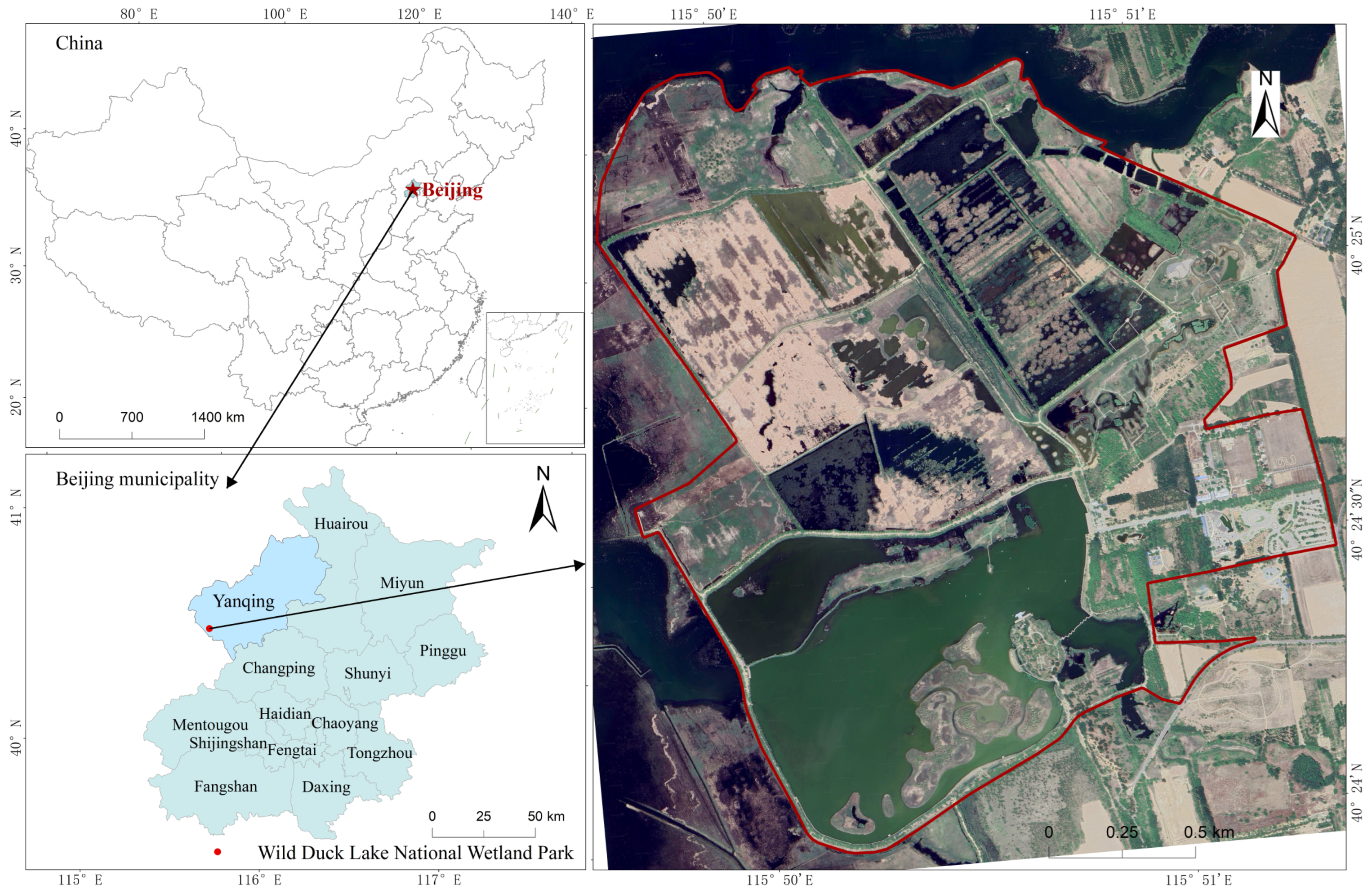


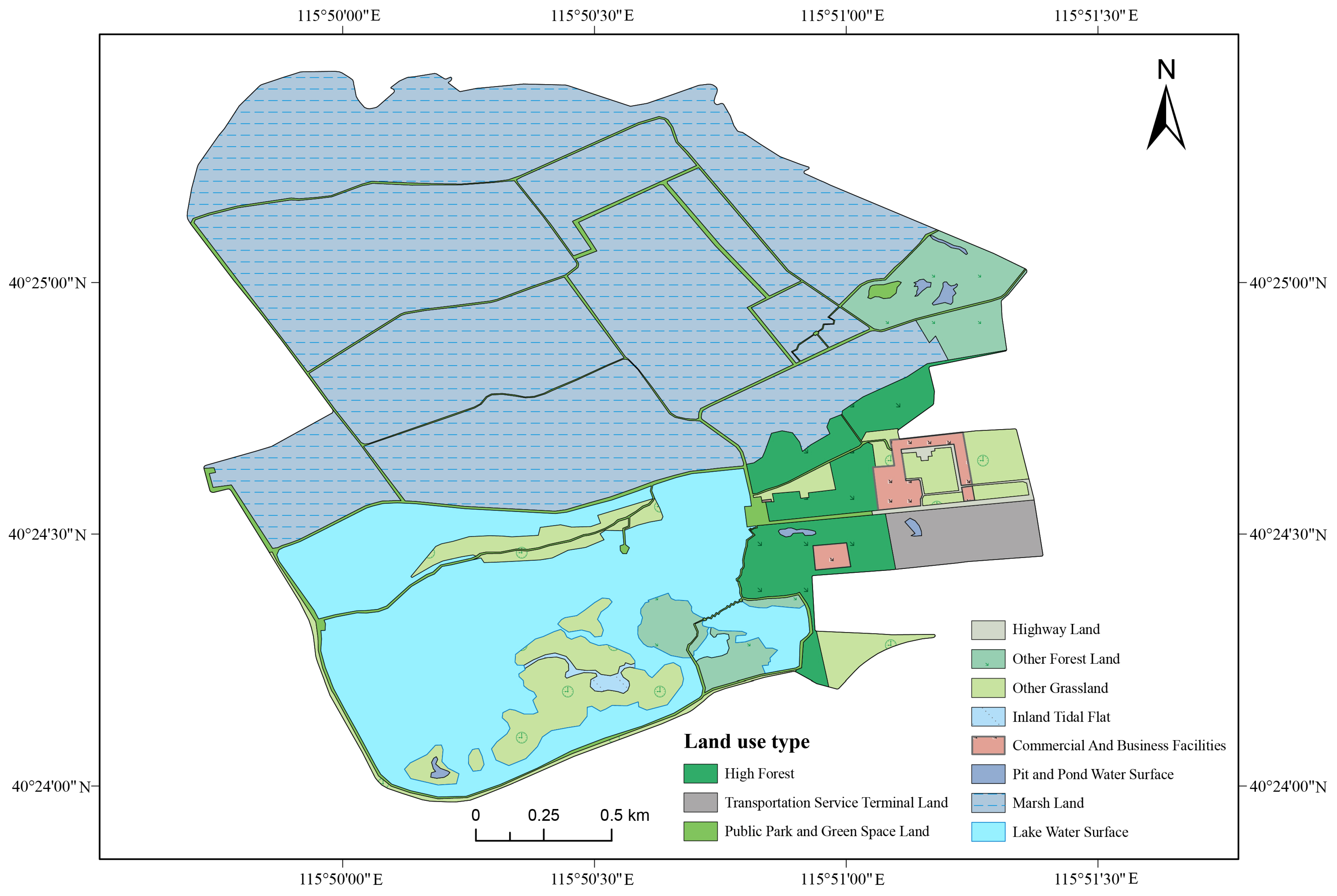
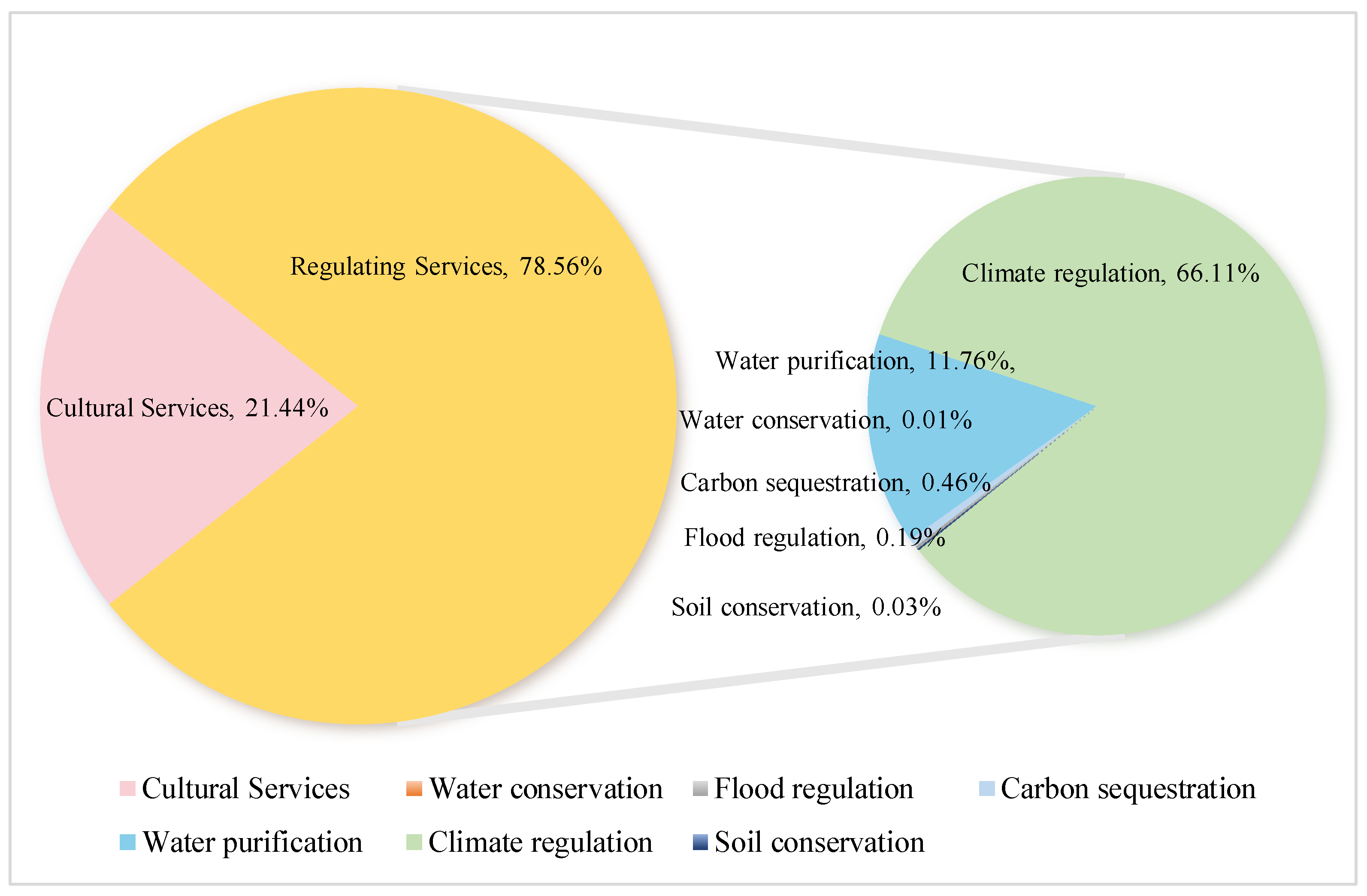
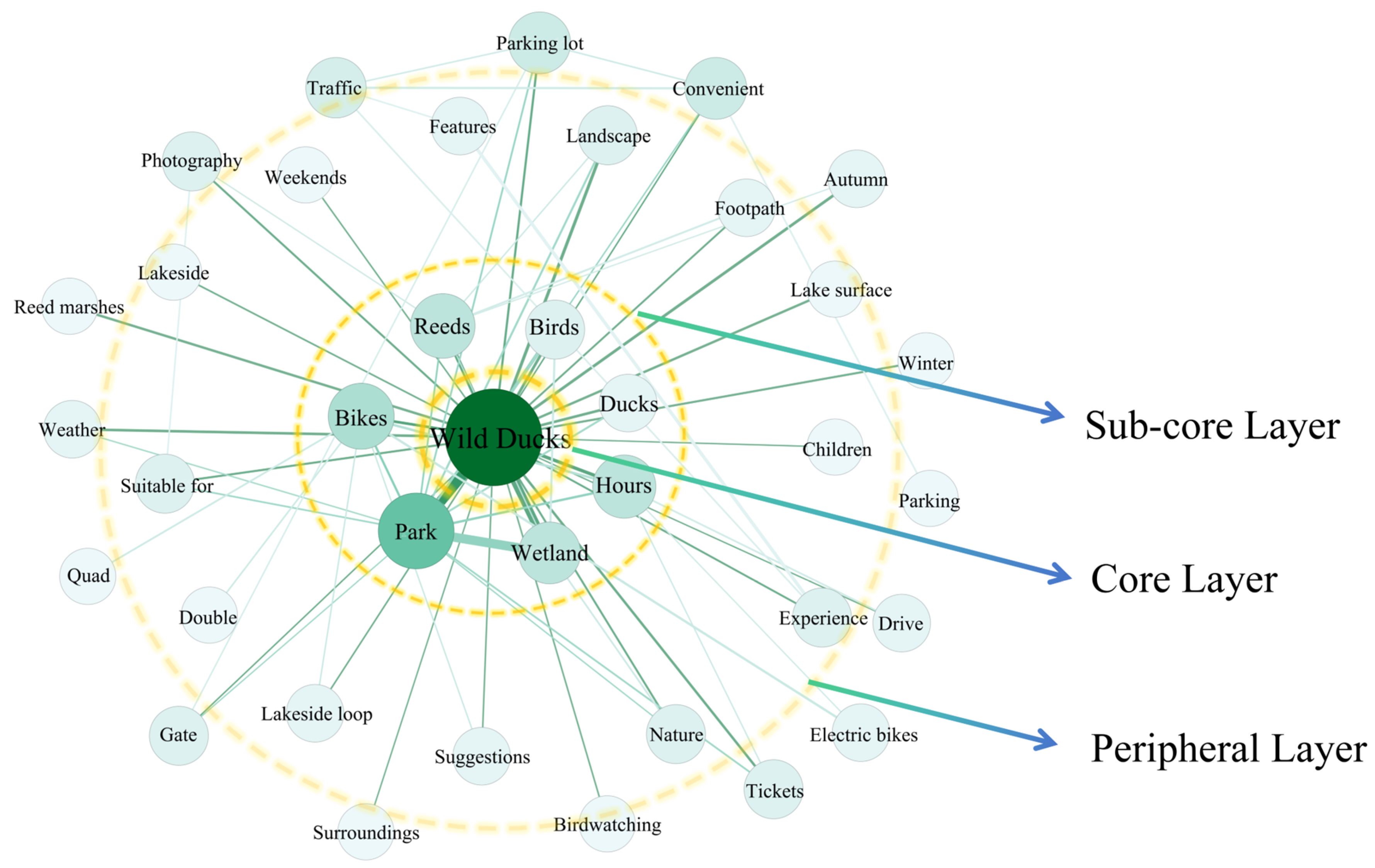
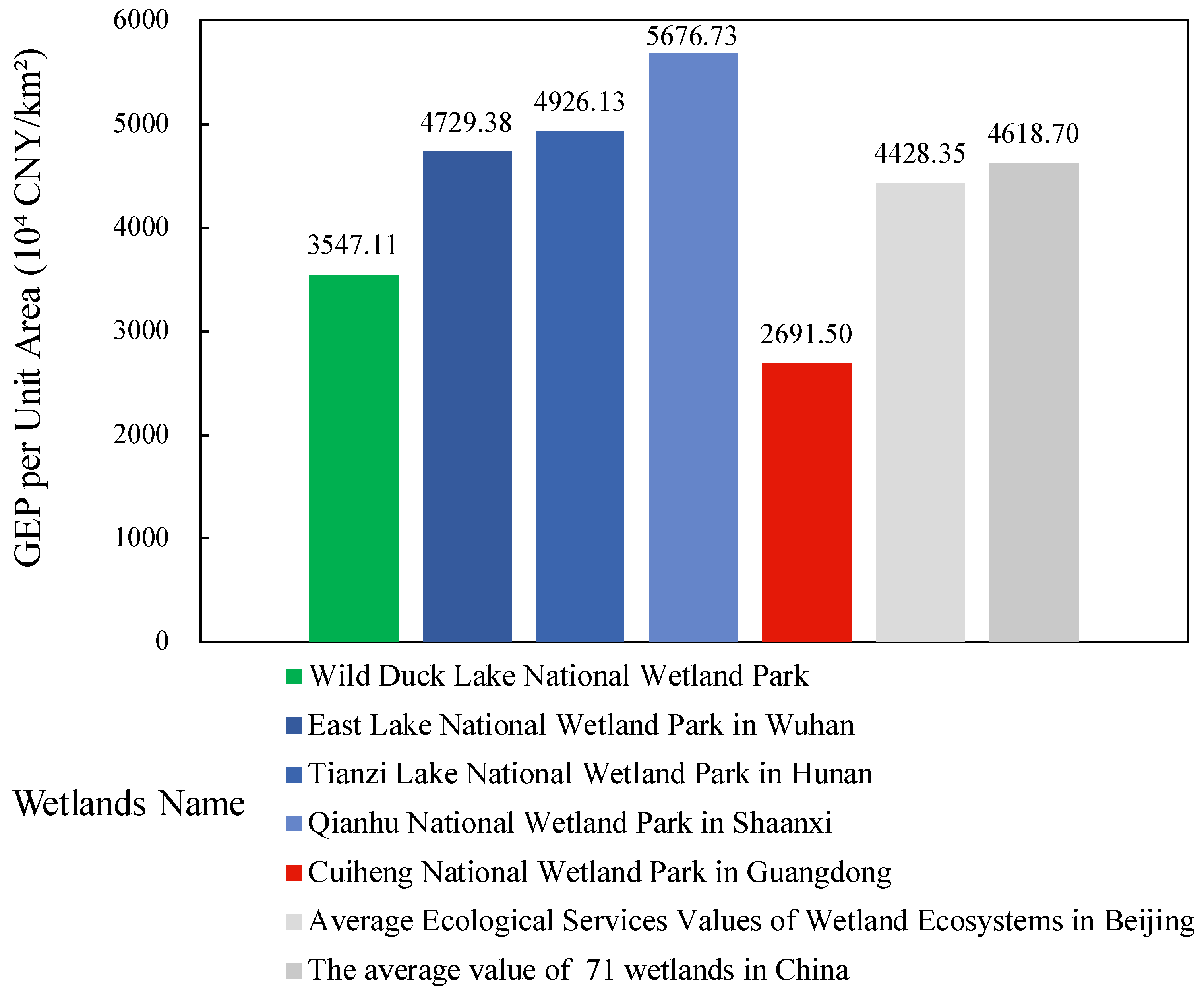
| Accounting Category | Accounting Indicator | Biophysical Quantity Accounting Method | Economic Valuation Accounting Method |
|---|---|---|---|
| Regulating Services | Water conservation | Water balance method | Replacement cost method |
| Flood regulation | Flood regulation model | Replacement cost method | |
| Carbon sequestration | Carbon sequestration model | Market value method | |
| Water purification | / | Unit area value equivalence method | |
| Climate regulation | Heat absorption model | Replacement cost method | |
| Soil conservation | Universal Soil Loss Equation (USLE) | Replacement cost method | |
| Cultural Services | Ecotourism And Health Preservation | Social media analysis | Travel cost method |
| Landscape Value Enhancement | Site survey and web crawling | Market value method |
| Accounting Stage | Parameter Name | Parameter Value | Data Description and Source |
|---|---|---|---|
| Biophysical Quantity | Wetland ecosystem area | 3.75 km2 | Vector data, current land use map of Wild Duck Lake National Wetland Park |
| Precipitation | 440.72 mm/a | Raster data, 30 m × 30 m, Nationwide rainfall distribution data, https://www.gisreal.cn/, accessed on 26 February 2025 | |
| Surface runoff | 30.7 mm/a | Raster data, 30 m × 30 m, National surface runoff data, https://www.gisreal.cn/, accessed on 26 February 2025 | |
| Total evapotranspiration | 385.64 mm/a | Raster data, 30 m × 30 m, National multi-year spatial distribution data of actual evapotranspiration (transpiration), https://www.gisreal.cn/, accessed on 26 February 2025 | |
| Economic Value | Engineering cost per unit of reservoir volume | 8.88 CNY/m3 | Specifications for assessment of forest ecosystem services [43] |
| Annual operating cost per unit reservoir capacity | 0.02 CNY/(m3·a) | Regulation for economic evaluation of water conservancy construction projects [44] | |
| Annual depreciation rate of reservoir | 0.95% | Code for rational service life and durability design of water resources and hydropower projects [45] |
| Accounting Stage | Parameter Name | Parameter Value | Data Description and Source |
|---|---|---|---|
| Biophysical Quantity | Lake area | 0.82 km2 | Vector data, current land use status map of Wild Duck Lake in 2023 |
| Economic Value | Engineering cost per unit of reservoir volume | 8.88 CNY/m3 | Specifications for assessment of forest ecosystem services [43] |
| Annual operating cost per unit reservoir capacity | 0.02 CNY/(m3·a) | Regulation for economic evaluation of water conservancy construction projects [44] | |
| Annual depreciation rate of reservoir | 0.95% | Code for rational service life and durability design of water resources and hydropower projects [45] |
| Accounting Stage | Parameter Name | Parameter Value | Data Description and Source |
|---|---|---|---|
| Biophysical Quantity | Conversion factor from carbon (C) to carbon dioxide (CO2) | 44/12 | Technical specification for gross ecosystem product accounting [42] |
| The net primary productivity | 3857.77 t | Raster data, 30 m × 30 m, China’s net primary productivity (NPP) data, https://www.gisrs.cn/, accessed on 26 February 2025 | |
| The carbon consumed by soil heterotrophic respiration | 1000.43 t | Soil microbial respiration model * [35] | |
| Economic Value | China’s carbon market price in 2023 | 68.13 CNY/t | Shanghai Environment and Energy Exchange |
| Accounting Stage | Parameter Name | Parameter Value | Data Description and Source |
|---|---|---|---|
| Economic Value | 2023 annual interest rate | 1.50% | People’s Bank of China |
| Water purification unit area equivalent | 3.6 CNY/m2 | Xie et al. [34] | |
| Wetland ecosystem area | 3,759,664.39 m2 | Vector data, current land use status map of Wild Duck Lake in 2023 | |
| Consumer price index of the evaluation year compared with the reference year | 132.7 | Beijing Statistical Yearbook 2024 |
| Accounting Stage | Parameter Name | Parameter Value | Data Description and Source |
|---|---|---|---|
| Biophysical Quantity | Evapotranspiration volume during air conditioning cooling | 918,324.42 m3 | Raster data, 30 m × 30 m, National multi-year spatial distribution data of actual evapotranspiration (transpiration), https://www.gisreal.cn/, accessed on 26 February 2025 |
| Density of water | 1 g/cm3 | / | |
| Latent heat of vaporization, the heat required to evaporate 1 g of water | 2257 J/g | Calculated | |
| Coefficient of performance for air conditioning | 3.30 | 2019 Residential Energy Saving Behavior Survey Report | |
| Evapotranspiration volume during humidifier operation | 130,003.55 m3/a | Raster data, 30 m × 30 m, National multi-year spatial distribution data of actual evapotranspiration (transpiration), https://www.gisreal.cn/, accessed on 26 February 2025 | |
| Power consumption of the humidifier per 1 m3 of water converted into steam | 150 kW·h/m3 | Calculated | |
| Economic Value | Local electricity prices for daily consumption | 0.53 CNY/kW·h | Beijing Municipal Development and Reform Commission |
| Accounting Stage | Parameter Name | Parameter Value | Data Description and Source |
|---|---|---|---|
| Biophysical Quantity | Area of wetland ecosystem | 3.75 km2 | Vector data, current land use status map of Wild Duck Lake in 2023 |
| Rainfall erosion factor for accounting unit | 1027.08 MJ·mm/(hm2·h·a) | Calculation based on empirical formulas derived from monthly rainfall | |
| Soil erodibility factor for accounting unit | 0.042 t·hm2·h/(hm2·MJ·mm) | Raster data, 30 m × 30 m, National high-precision soil erodibility factor K data, https://www.gisrs.cn/, accessed on 26 February 2025 | |
| Slope length factor for accounting unit | 0.677 | Calculated based on slope length | |
| Slope factor for accounting unit | 0.057 | Calculated based on slope | |
| Vegetation cover factor for accounting unit | 0.708 | Calculated based on NDVI (Normalized Difference Vegetation Index) and FVC (Fractional Vegetation Cover) | |
| Soil conservation factor | 0 | Wetlands take the value 0 | |
| Economic Value (Reduced Sedimentation Value) | Engineering cost per unit of sedimentation removal | 121.89 CNY/m3 | Guanting Reservoir Dredging Pilot Project (Construction) Tender Announcement |
| Sedimentation coefficient | 0.24 | Wang et al. [46] | |
| Economic Value (Reduced Non-Point) Source Pollution Value) | Pure nitrogen content in soil | 0.10% | Raster data, 90 m × 90 m, Shi et al. [47] |
| Pure phosphorus content in soil | 0.04% | Raster data, 90 m × 90 m, Shi et al. [47] | |
| Unit treatment cost of comprehensive non-point source pollutants | 47,552 CNY/t | Calculated based on cost-effectiveness approach |
| Accounting Stage | Parameter Name | Parameter Value | Data Description and Source |
|---|---|---|---|
| Biophysical Quantity | Total number of visitors | 300,000 persons/year | https://www.bjyouth.com.cn/, accessed on 5 February 2025 |
| Economic Value | Average travel cost per visitor | 140.73 CNY/person-time | Social Media Data (Section 2.2.4) and the Wild Duck Lake National Wetland Park Conceptual Master Plan |
| Tendency of visitors’ average travel cost towards natural landscapes | 78% | Social Media Data |
| Accounting Stage | Parameter Name | Parameter Value | Data Description and Source |
|---|---|---|---|
| Biophysical Quantity | Number of hotels benefiting from landscape appreciation | 159 hotels | POI data of Beijing in 2023 (using ArcMap (Version 10.6) spatial analysis, a hotel buffer zone within 5 km of the wetland park was identified (Figure S1)) |
| Number of hotel rooms benefiting from landscape appreciation | 647 nights/a | https://www.ctrip.com/, accessed on 7 February 2025 (Table S1) | |
| Economic Value | Average hotel room price | 337.27 CNY/night | https://www.ctrip.com/, accessed on 7 February 2025 (Table S1) |
| Landscape premium coefficient for rooms | 139% | https://www.ctrip.com/, accessed on 7 February 2025 |
| Parameter | Value | Data Source (For Specific Keywords, See the Supplementary Instructions) |
|---|---|---|
| Preference for natural landscape | 78% | Keyword search (Table S2) |
| Average one-way travel time to the core site | 2.25 h | Keyword search (Table S2) |
| Average one-way travel cost to the core site | 89.74 CNY | Keyword search (Table S2) |
| Average time spent at the core tourism site | 2.93 h | Keyword search (Table S2) |
| Average daily wage of tourists | 213.31 CNY/day | Tourist IP-based statistics |
| First-Level Classification | Second-Level Classification | Area (ha) |
|---|---|---|
| Grassland | Other Grassland | 43.34 |
| Public Management and Public Service | Public Park and Green Space Land | 6.04 |
| Land for Transportation Purposes | Transportation Services Terminal Land | 8.42 |
| Highway Land | 1.57 | |
| Forest Land | Other Forest Land | 8.67 |
| High Forest | 9.84 | |
| Commercial service land | Commercial and Business Facilities Land | 4.27 |
| Wetland | Marsh Land | 247.50 |
| Inland Tidal Flat | 1.01 | |
| Water Areas and Water Conservancy Facilities Land | Pit and Pond Surface | 1.12 |
| Lake Water Surface | 87.12 |
| Accounting Category | Accounting Indicator | Value (104 CNY) | Proportion | Total (104 CNY) | Unit Value (104 CNY/km2) |
|---|---|---|---|---|---|
| Regulating Services | Water conservation | 0.77 | 0.01% | 15,500.89 | 3547.11 |
| Flood regulation | 29.76 | 0.19% | |||
| Carbon sequestration | 71.38 | 0.46% | |||
| Water purification | 1823.01 | 11.76% | |||
| Climate regulation | 10,247.26 | 66.10% | |||
| Soil conservation | 5.19 | 0.03% | |||
| Cultural Services | Ecotourism And Health Preservation | 3293.19 | 21.25% | ||
| Landscape Value Enhancement | 30.33 | 0.20% |
| Rank | Keyword | Frequency | Rank | Keyword | Frequency |
|---|---|---|---|---|---|
| 1 | Wild Duck | 2600 | 31 | Free | 228 |
| 2 | Scenery | 1227 | 32 | Playing | 227 |
| 3 | Reeds | 1124 | 33 | Tourist | 218 |
| 4 | E-scooter | 920 | 34 | Distance | 218 |
| 5 | Wetland | 902 | 35 | Urban Area | 215 |
| 6 | Bicycle | 794 | 36 | Air | 210 |
| 7 | Duck | 719 | 37 | Nice View | 203 |
| 8 | Tickets | 668 | 38 | Couples | 201 |
| 9 | Bird Species | 558 | 39 | Foursome | 195 |
| 10 | Weather | 494 | 40 | Lake Water | 183 |
| 11 | Parking Lot | 473 | 41 | Friends | 177 |
| 12 | Convenient | 462 | 42 | Walk | 177 |
| 13 | Photo | 450 | 43 | Binoculars | 177 |
| 14 | Suggestion | 444 | 44 | Boating | 173 |
| 15 | Plank Road | 443 | 45 | Beautiful | 171 |
| 16 | Water Surface | 423 | 46 | Comfortable | 165 |
| 17 | Traffic | 389 | 47 | Elderly | 162 |
| 18 | Bird watching | 375 | 48 | Cycling | 160 |
| 19 | Lakeside | 359 | 49 | Reservoir | 159 |
| 20 | Kids | 359 | 50 | View | 158 |
| 21 | Entrance | 357 | 51 | Worth It | 158 |
| 22 | Lakeside Path | 332 | 52 | Afternoon | 156 |
| 23 | Season | 330 | 53 | Downhill | 152 |
| 24 | Environment | 318 | 54 | Surprised | 146 |
| 25 | Nature | 311 | 55 | Migratory Birds | 140 |
| 26 | Park Area | 285 | 56 | Relaxing | 143 |
| 27 | Driving | 275 | 57 | Animals | 138 |
| 28 | Parking | 275 | 58 | Fee | 138 |
| 29 | Rental Car | 239 | 59 | Blue Sky | 137 |
| 30 | Weekend | 231 | 60 | Sightseeing | 137 |
| Wetlands Name | GEP per Unit Area (104 CNY/km2) | Proportion of Regulating Services | Proportion of Cultural Services |
|---|---|---|---|
| Wild Duck Lake National Wetland Park | 3547.11 | 74.12% | 25.88% |
| East Lake National Wetland Park in Wuhan | 4729.38 | 28.41% | 71.59% |
| Tianzi Lake National Wetland Park in Hunan | 4926.13 | 95.04% | 4.96% |
| Qianhu National Wetland Park in Shaanxi | 5676.73 | 97.56% | 2.44% |
| Cuiheng National Wetland Park in Guangdong | 2691.50 | 86.51% | 13.49% |
Disclaimer/Publisher’s Note: The statements, opinions and data contained in all publications are solely those of the individual author(s) and contributor(s) and not of MDPI and/or the editor(s). MDPI and/or the editor(s) disclaim responsibility for any injury to people or property resulting from any ideas, methods, instructions or products referred to in the content. |
© 2025 by the authors. Licensee MDPI, Basel, Switzerland. This article is an open access article distributed under the terms and conditions of the Creative Commons Attribution (CC BY) license (https://creativecommons.org/licenses/by/4.0/).
Share and Cite
Cui, Y.; Yang, Z.; Zhou, Q.; Yang, M.; Liang, S.; Zhang, J.; Wang, K. Gross Ecosystem Product (GEP) Accounting and Sustainable Management Pathways for Wild Duck Lake National Wetland Park, Beijing, China. Water 2025, 17, 3321. https://doi.org/10.3390/w17223321
Cui Y, Yang Z, Zhou Q, Yang M, Liang S, Zhang J, Wang K. Gross Ecosystem Product (GEP) Accounting and Sustainable Management Pathways for Wild Duck Lake National Wetland Park, Beijing, China. Water. 2025; 17(22):3321. https://doi.org/10.3390/w17223321
Chicago/Turabian StyleCui, Yuxuan, Zihan Yang, Qiyuan Zhou, Mingrui Yang, Sen Liang, Jianjun Zhang, and Ke Wang. 2025. "Gross Ecosystem Product (GEP) Accounting and Sustainable Management Pathways for Wild Duck Lake National Wetland Park, Beijing, China" Water 17, no. 22: 3321. https://doi.org/10.3390/w17223321
APA StyleCui, Y., Yang, Z., Zhou, Q., Yang, M., Liang, S., Zhang, J., & Wang, K. (2025). Gross Ecosystem Product (GEP) Accounting and Sustainable Management Pathways for Wild Duck Lake National Wetland Park, Beijing, China. Water, 17(22), 3321. https://doi.org/10.3390/w17223321








